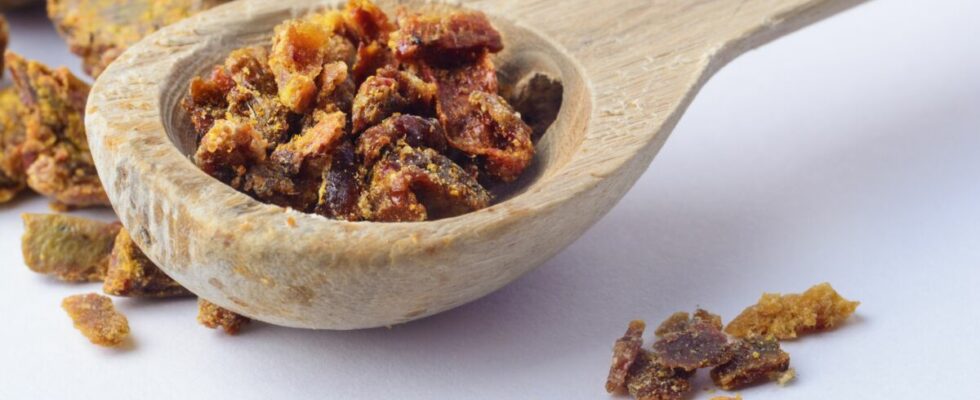Collected by bees from certain parts of trees, propolis is used to structure the architecture of the hive by consolidating and repairing its walls. Used by the Egyptians, the Romans and many other civilizations, this substance with countless properties continues to reveal its secrets. Long abandoned in the face of the rise of medicine, propolis is now enjoying a comeback. What are its virtues? In what form is it consumed?
What are the therapeutic properties of propolis?
Varying from light yellow to dark brown, propolis is a resin mainly collected by bees from the buds of poplar trees. Particularly rich in flavonoids, this natural substance has a widely documented antioxidant action. By helping to neutralize free radicals, it has anti-aging and regenerating properties highly appreciated by the cosmetic and pharmaceutical industry. In addition, propolis also has bactericidal, antifungal, antiparasitic and antiviral properties recognized and demonstrated by the scientific community. It is therefore very useful to fight against various conditions (gastroenteritis, candidiasis, otitis, flu…) and to strengthen the immune system in winter in particular. In popular medicine, this fruit of the work of bees is also used for anti-inflammatory purposes. Its administration helps, in fact, to reduce inflammation and, in fact, to relieve muscular or joint pain.
How is propolis used?
There is not one, but several types of propolis which differ essentially by their geographical origin and their flavonoid content. We find red propolis, green propolis and brown propolis. The latter represents the most common in Europe. Available in pharmacies and drugstores, the substance comes in a multitude of dosage forms. Usually administered orally in capsules, propolis can also be used in liquid form for faster assimilation.
For people with a sore throat, for example, the resin is often consumed in chewing gum or lozenges for more localized relief. The spray will be favored, for its part, in the context of mild oral and dental disorders (canker sores, gingivitis, halitosis, etc.). The form chosen will depend above all on the desired objective. But in all cases, it is strongly recommended to opt for natural and certified products which respect French and European quality standards.
What are the precautions for using propolis?
If propolis is by definition a natural substance, it is nonetheless composed of active ingredients which have a notable impact on the body. In this respect, it is appropriate to scrupulously respect the instructions mentioned in the instructions for use. However, the low toxicity of the substance makes it a product that can be used by a very large part of the population. Only people with or who have had an allergic reaction to bee products or bee stings should refrain from consuming them. On the other hand, the use of propolis is also not recommended for pregnant and breastfeeding women as well as young children (under 3 years old).
How to take propolis?
Propolis is generally consumed as a treatment lasting a few days or weeks. The dosage and method of administration of propolis will depend on the form used. For optimal effectiveness, it is therefore advisable to refer to the instructions for use and, if possible, to obtain prior medical advice. The recommended amount is approximately 3 grams per day for fresh propolis, 50 drops three times per day for the mother tincture, and 100 to 200 milligrams three times per day for the powder or dry extract (based on the thesis Apitherapy by Mathilde Baudel, at the University of Picardie Jules Verne).
Inappropriate or excessive use of propolis-based products can – rarely – have undesirable effects. Used locally on the skin, the substance can trigger an allergic reaction (allergic rhinitis, hives, pruritus, redness, etc.). To avoid this type of inconvenience, specialists recommend testing the product first on a small area of the skin (earlobe, inside of the elbow or knee, etc.). Cases of gastrointestinal disturbances and laryngeal edema with anaphylactic shock have also been reported, particularly in cases of interaction with other medicinal products. In particular, there is a risk of cross allergy between propolis and tiger balm or Peru balsam, usually used to relieve joint pain.
Sources
Propolis, properties and therapeutic interestPotter Florence, University of Lorraine, June 3, 2014
ApitherapyMathilde Baudel, Picardie Jules Verne University, April 28, 2017
Food supplement – PropolisVidal
Read also :
⋙ Propolis, royal jelly… Bees are our allies this winter!
⋙ Allergic to pollen? Avoid royal jelly and propolis
⋙ Apitherapy: I treat myself with bees
